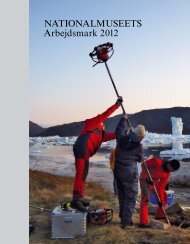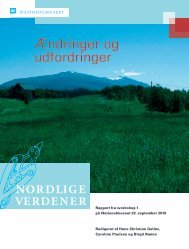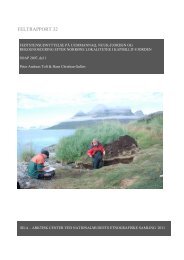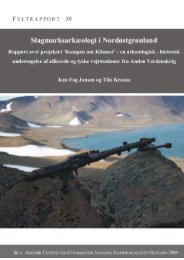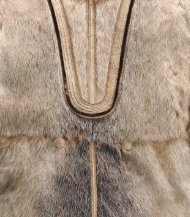The Border of Farming and the Cultural Markers - Nordlige Verdener
The Border of Farming and the Cultural Markers - Nordlige Verdener
The Border of Farming and the Cultural Markers - Nordlige Verdener
You also want an ePaper? Increase the reach of your titles
YUMPU automatically turns print PDFs into web optimized ePapers that Google loves.
48<br />
eral dykes among which was a smaller<br />
circular dyke. <strong>The</strong> house is somewhat<br />
dilapidated with many boulders tumbled<br />
in <strong>and</strong> <strong>the</strong> site could be <strong>of</strong> a somewhat<br />
younger date. Fur<strong>the</strong>r to <strong>the</strong> West at<br />
Ness <strong>of</strong> Nounsbrough <strong>and</strong> down to Gruni<br />
Gill, by Ini Fiord <strong>and</strong> exposed to <strong>the</strong><br />
South we mapped two house structures,<br />
a circular dyke <strong>and</strong> o<strong>the</strong>r dykes indicating<br />
that <strong>the</strong> two houses could be contemporary.<br />
Fig. 9<br />
<strong>The</strong>se few examples give a picture <strong>of</strong> a<br />
variation in settlement structures: Single<br />
house structures lying alone; small<br />
communities consisting <strong>of</strong> two or more<br />
house holds with field systems; <strong>and</strong> finally<br />
clusters <strong>of</strong> houses such as <strong>the</strong> one at<br />
Pin houll<strong>and</strong> consisting <strong>of</strong> five to six structures.<br />
As far as I know <strong>the</strong> house cluster<br />
at Pinhoull<strong>and</strong> st<strong>and</strong>s alone on Shetl<strong>and</strong>,<br />
but fur<strong>the</strong>r surveys <strong>and</strong> mapping will undoubtedly<br />
reveal that this kind <strong>of</strong> settlement<br />
type is more widespread.<br />
Conclusion<br />
I have concentrated my work on West<br />
Mainl<strong>and</strong>, Shetl<strong>and</strong> <strong>and</strong> I am thus unable<br />
to say whe<strong>the</strong>r <strong>the</strong> above sketched<br />
picture is representative for <strong>the</strong> settlement<br />
structure on Shetl<strong>and</strong> as a whole<br />
during <strong>the</strong> Neolithic Period or Older<br />
Bronze Age. It looks as if Shetl<strong>and</strong> has a<br />
much more complicated settlement structure<br />
during <strong>the</strong> Neolithic Period than<br />
earlier observed. It is also suggestive<br />
that <strong>the</strong> nearest parallel to <strong>the</strong> cluster <strong>of</strong><br />
houses at Pinhoull<strong>and</strong> – as far as <strong>the</strong><br />
surveys indicate – is Skara Brae <strong>and</strong><br />
o<strong>the</strong>r <strong>of</strong> <strong>the</strong> clusters/villages <strong>of</strong> Late Neolithic<br />
or Older Bronze Age origins from<br />
Orkney. This also implies that we have<br />
to reconsider <strong>the</strong> cultural connections<br />
between <strong>the</strong> North Atlantic isl<strong>and</strong>s,<br />
which challenge <strong>the</strong> idea <strong>of</strong> isolation<br />
during this period. We should all be well<br />
aware that all <strong>the</strong>se indications are<br />
based on surveys <strong>and</strong> <strong>the</strong>refore are built<br />
on peaty ground – so to say in “Shetl<strong>and</strong>ic”<br />
terms.<br />
Orkney has a rich <strong>and</strong> varied Neolithic<br />
Period, which among o<strong>the</strong>r factors is<br />
caused by <strong>the</strong> intense interest from antiquarians<br />
<strong>and</strong> archaeologists in Orkney<br />
prehistory over a considerable span <strong>of</strong><br />
time. Shetl<strong>and</strong> on <strong>the</strong> o<strong>the</strong>r h<strong>and</strong> has<br />
lacked <strong>the</strong> same magnetism seen from a<br />
19 th <strong>and</strong> 20 th Century view, which is no<br />
critique <strong>of</strong> <strong>the</strong> archaeological investigations<br />
in Orkney, but may be more an indication<br />
<strong>of</strong> where <strong>the</strong> prestige has been<br />
placed. <strong>The</strong> last 15-20 years has changed<br />
much both concerning published excavations<br />
(Turner 1998; Fojut 2006; Dockrill<br />
et al. 1998: 61; AOC Archaeology<br />
Group), excavations especially <strong>of</strong> Iron<br />
Age – Viking Age structures <strong>and</strong> exhibitions<br />
among o<strong>the</strong>r things thanks to <strong>the</strong><br />
investments in Hay’s Dock.




